Wild and Wonderful
With her feet in the tussocks, artist Jacqui Gibbs Chamberlain shares a busy farming life with husband Chris at their remote, beautiful Port Levy property on Banks Peninsula. In her studio, Jacqui’s imagination takes flight to places wild and wonderful. Words Kim Newth, Photos Alister Winter.
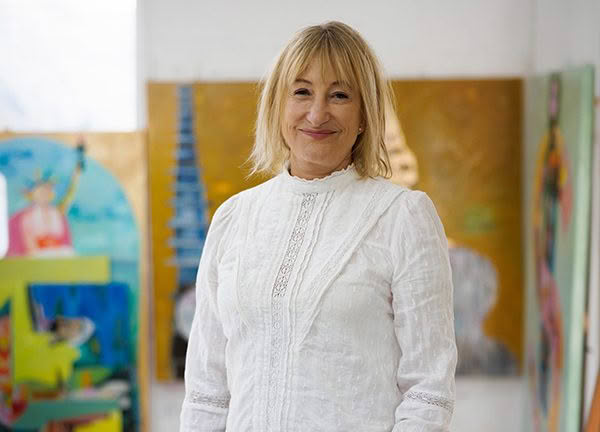
Putiki Farm is at the end of a long gravel road at Port Levy (Potiriwi)/Koukourarata. It’s a good hour’s drive from Ōtautahi Christchurch to reach the farm gate. The landscape here is open and elemental, from the blues of sky and sea to the browns and golds of tussocks and the white backs of sheep.
At the farmhouse, Chris and Jacqui Gibbs Chamberlain welcome me into their home, revealing an interior that’s alive with Jacqui’s colourful, vibrant art. Their living space looks out over the calm waters of the bay. With 13 km of coastline, Chris says the farm hills provide a view at every step. ‘You can virtually look right down along the Southern Alps. To the north you can see the mouth of Lyttelton Harbour and New Brighton Pier and the vista towards Motunau and Kaikōura. The land here has a good feeling.’
Their regenerative, low-input farm system is founded on stewardship: ‘We’re total caretakers of this land,’ says Jacqui. ‘When we pass it on to the next generation, we want it to be as best as possible.’
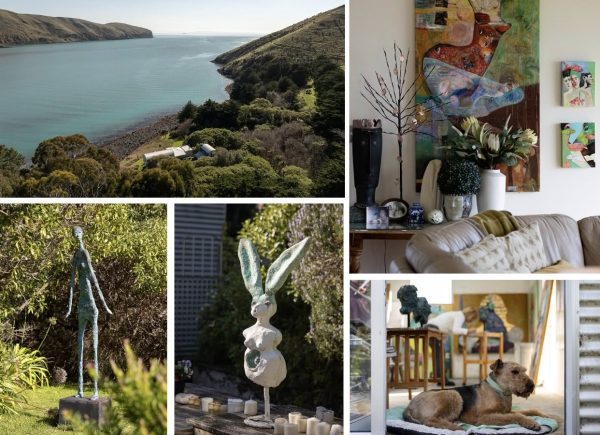
Through a sheltered sunny courtyard at the back of the house and up a flight of stairs is Jacqui’s studio. Here is a different world. Goldfish swim around temples and gunslingers figuratively roam through a series of surrealist oil paintings, bound for an exhibition at Little River Gallery called Proof of Love. People sometimes ask Jacqui why she doesn’t paint landscapes, given the spectacular scenery all around. Instead, her work is mostly figurative and deeply imaginative. ‘To be honest, farming is so immense,’ she says. ‘I find I need my imagination to take me places and I enjoy doing crazy things in my art. As I start painting, it simply evolves – layer by layer.’
Love through Jacqui’s playful, pop art influenced lens can be loyal like a companionable dog or dangerous like a cowboy raising a gun above a pair of weeping Marilyn Monroes. Love can be expressed as a triangle, a gift, swirling pools of watery desire, or a reflection in a mirror.
Love through Jacqui’s playful, pop art influenced lens can be loyal like a companionable dog or dangerous like a cowboy raising a gun above a pair of weeping Marilyn Monroes.
For this exhibition, Jacqui has also sculpted mixed media busts of family members, including her mother Maureen and daughter Phoebe.
What better proof of love and respect can there be than this? ‘They look like they could have come from the sea,’ muses Jacqui, running a hand thoughtfully over sculpted waves of dark turquoise blue. It feels like an intimate gesture to immortalise loved ones in this way, as opposed to sculpting some public figure for a plinth. The busts have a textured patina that evokes old bronze, brought into the light.
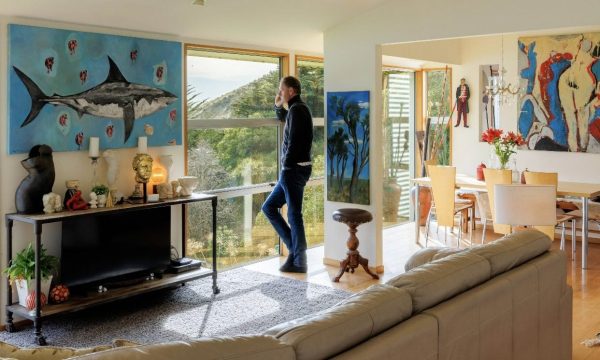
Jacqui says recent interest in her art has shot up, so along with preparing this exhibition she has been working on a number of commissioned art pieces. ‘It has been great being approached by people who respect my work as an imaginative abstract artist. I’m keen to do more commissions and have got a good process for that now. People find me on Instagram – the power of that reach is incredible.’
Sometimes, when she’s on a roll, Jacqui will work in her studio all day and night. There’s always something new and quirky on the go. In May 2024, she contributed a series of small dog sculptures as guest artist at the Hōhepa Art and Sculpture Exhibition in Christchurch.
Jacqui credits her mother, a landscape artist, for encouraging her creativity and they have painted together through the years. ‘My mum Maureen, who is now 92, owned a gallery and has painted all her life.’
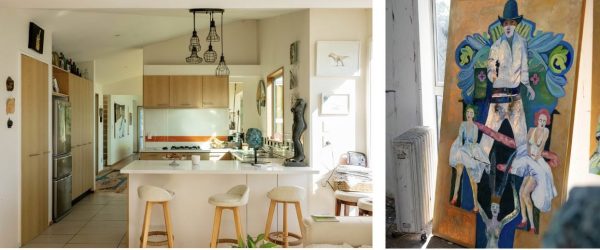
Maureen grew up in Sydney and Jacqui often travelled there with her to attend art lessons. Now Phoebe is further reinforcing that Australian connection, working in Sydney in product marketing. Jacqui and Chris are very proud of how well their daughter is doing, putting her agribusiness degree from Lincoln University to good use.
Many years earlier, Chris and Jacqui were themselves students at Lincoln University. Jacqui grew up in Upper Hutt – seemingly a long way from the country – but rode horses from the age of 10 and had cousins who lived on farms in the Wairarapa. Seeing a future for herself in horticulture, she enrolled at Lincoln University in time to meet Chris who was studying agriculture there.
Chris grew up on a cropping farm in Leeston, but always had his heart set on becoming a sheep and beef farmer. Fresh off the Canterbury Plains, his first impulse as a teenager was to jump in a car with three dogs bound for Gisborne. ‘I was totally green,’ admits Chris. ‘I was a flatland boy who had never ridden a horse and got put on a polo pony! But I loved it. I learned a lot by working for some very good farmers, who were happy to pass on their knowledge around shepherding and the business of farming. Jac’s father Colin, who was a very successful businessman, was a great help with the business side of it too.’
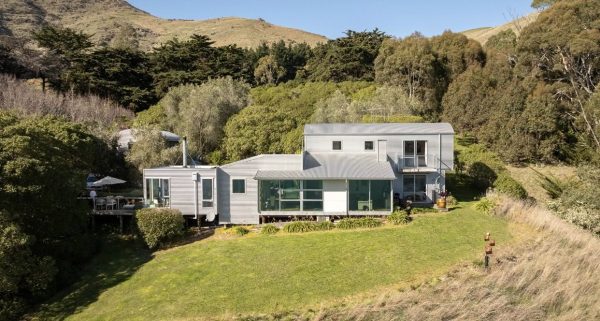
In 1987, when Chris and Jacqui first took up Putiki Farm, it had been run by absentee owners for many years. The farmhouse turned out to be a tiny ramshackle cottage (later converted to an art studio). In those early years, Chris and Jacqui did all the farm work themselves, equipped only with two horses, a team of dogs, an old Land Rover and a two-wheel motorbike. It was a baptism of fire when the worst drought anyone could remember hit in 1988/89.
‘We took all the stock off here and walked our ewes from here to Little River and then the Canterbury Plains where we grazed them to the end of June before walking them back,’ recalls Chris. ‘It was hard work but something we had to do – it got us through.’
Jacqui credits her mother, a landscape artist, for encouraging her creativity and they have painted together through the years.
Mustering by horseback was the norm for many years, with Jacqui invariably first up to get the horses saddled and ready to go. Chris reckons horses are naturally drawn to Jacqui – or to the carrot in her back pocket! Originally their 1,000-hectare farm was much smaller. Today, a truck is used to get the mustering team (led by shepherd Tom Redwood) to the top of the farm. This summer-dry tussock country is drought prone, hence their annual on-farm lamb muster and sale in mid-November. ‘We farm to have early lambs that we can sell at the start of the season. We also have a 170-hectare irrigated flatland block at Leeston where we finish some progeny ourselves and grow crops.’
Their farmhouse at Port Levy dates back to 1999 and was completed two years after Phoebe was born. Renowned Christchurch architect Alec Bruce created the award-winning design. ‘Alec really nailed the indoor/outdoor living that we were after, as well as framing the views to the north,’ says Jacqui. ‘There’s no wasted space – like hallways – as we were on a very strict budget.’ Landscape designer Ben McMaster helped plan the courtyard garden – a perfect play space for young Phoebe all those years ago – that includes hardy trees like ngaio and olives.
The dry coastal climate makes it hard to sustain a well-defined country garden. It doesn’t seem to matter though. On the lawn, sloping down to the seashore, are Jacqui’s sculptures – one, a woman skipping, and the other, a man holding out a bouquet as if to welcome passing boats. They naturally draw the eye, along with a kinetic sculpture by Christchurch artist Matthew Williams.
Collecting others’ art is something Jacqui enjoys. She owns pieces by her friend Gill Hay, who managed Sculpture on the Peninsula for many years. Jacqui was a regular participant in that event too. She and Gill have shared many adventures together, including a trip to Italy one year to attend an international art workshop.
Jacqui has travelled extensively, attending art workshops and learning from various teachers, here and abroad. In 2002, she was accepted to paint at a New York art school and in 2011 went to Papunya in Australia’s Northern Territory to help photograph and catalogue artworks for the Aboriginal arts community there. That memorable experience inspired a solo exhibition in 2012 called Walk-a-bout. Next year, she hopes to travel to Mexico for an arts residency called Arthouse Pani.
You can experience Jacqui’s work for yourself at Te Matatiki Toi Ora The Arts Centre’s annual Sculpture Festival, from 5–20 October, Christchurch.
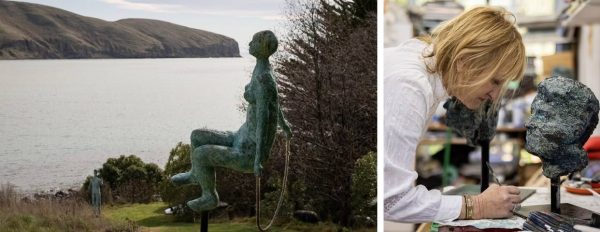
Growing the value of Banks Peninsula strong wool
Chris and Jacqui are founding members of Banks Peninsula Farms Wool Growers, a group of local farmers that came together in 2009 to tell the story of their wool and the sustainable farming practices behind it.
‘Everyone was working with different brokers at the time and not getting a lot out of it or gaining any insights into the needs of the consumer,’ says Chris. ‘We realised we were all producing similar bright, white wool, so why not combine it all to achieve critical mass? This has given us greater control as well as a much better understanding of our end consumer.’
Once scoured, all their fleece wool goes to Europe and is spun into yarn before being sent to the United States to be used in high-end wool products under the Banks Peninsula Farms brand. The whole process provides transparency and full traceability, starting with the farming families that grow the wool through to how it is produced and made into a luxury product in the United States.
‘We’re giving our wool a chance to shine as a 100 per cent natural premium fibre that’s grown sustainably, and if it winds up in a landfill at its end-of-life cycle, it will break down – unlike the plastics that wool is competing against.’
As the group’s artist, Jacqui has developed a range of unique, bold designs used to create luxurious bespoke rugs, with plans to develop that concept further in future.
Banks Peninsula Farms Wool Growers also supply wool to Terra Lana in Christchurch, which processes New Zealand wool to make products for the construction sector for use in high-performance insulation and acoustics.

